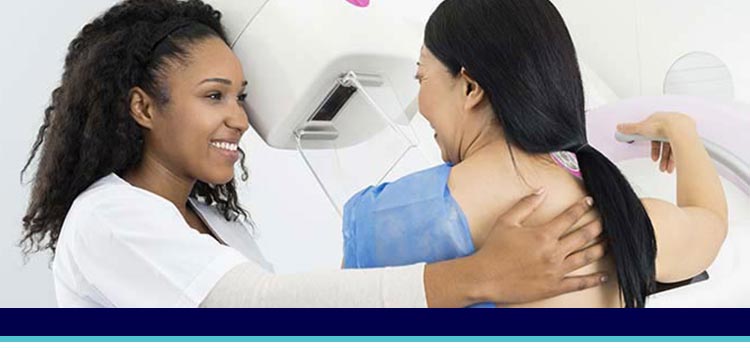Mammogram Screening Q&A
Staying on top of your screening mammograms is key to preventing advanced breast cancer. If you notice discomfort, an inverted nipple, lumps, nipple discharge, redness or swollen lymph nodes get your mammogram screening immediately. Internal Medicine and Family Practice offers mammogram screening in Joliet, IL. You can also consult our primary care doctors, including Dr. Samiullah Choudry and Dr. Wael Mctabi, MD. Book an appointment online or contact us. We are located at 1719 Glenwood Ave Joliet, IL 60435.


Table of Contents:
What is a mammogram screening?
How often is mammogram screening recommended?
What are the symptoms of breast cancer?
What are the types of breast cancer?
How long will it take to get my results?
If you are a woman in good health, you may think mammogram screenings are not something to concern yourself with. However, mammogram screenings are conducted to make sure you stay in good health! While women under 40 years old without symptoms of breast cancer generally do not require mammogram screenings, it is a good idea to have regular screenings if you are 40 years of age or more. To give you a better idea of what mammogram screening involves, we have answered some commonly asked questions about mammograms below!
A mammogram screening involves X-ray imaging of the breast to look for early signs of breast cancer. As such, mammogram screenings are conducted to catch breast cancer in its early stages when it is the most treatable, even before any lumps show up, as a preventive measure.
The X-rays used in mammogram screening have two plastic plates that go above and below the breasts and compress the breast tissue, allowing mammogram X-rays to use lower doses of radiation than standard X-rays to produce a clear image.
During a mammogram screening, patients stand in front of the X-ray machine, and an X-ray technician will guide the patient to place their breast on top of the bottom plate. The technician will use the mammogram machine to bring the top plate over the breast, and both plates will then compress the breast tissue. You will feel some pressure during this process, perhaps some pain and discomfort, but the X-ray will only take a few moments. The process will be repeated to obtain a profile view of the breast and then again to obtain X-ray images of the other breast.
Including time spent in the waiting room, pre-exam questioning, changing into a medical gown, and the mammogram itself, a mammogram screening will likely take around 30 minutes to complete.
The American Cancer Society (ACS) recommends that women between the ages of 40 and 44 consider having annual mammogram screenings, and women aged 45 to 54 should especially have yearly mammogram screenings. For women aged 55 and older, ACS advises that having mammogram screenings every two years is acceptable, or they can continue with annual screening. They also recommend that mammogram screening continue as long as a woman is healthy and expected to live for ten years or more.
Breast cancer can occur with a variety of different symptoms or no symptoms at all. With that being said, some common signs and symptoms of breast cancer include the following:
– Dimpling or irritation of the breast skin
– Discharge from the nipple, other than breast milk, such as blood
– Flaky skin or redness around the nipple
– Pain in the breast or nipple
– New lump in the breast or armpit
– Swelling or thickening of some of the breast tissue
– Unexplained changes in breast size or shape
There are several different types of breast cancer that are differentiated according to their location, whether they are invasive, non-invasive, or metastatic, if they are a molecular subtype of a particular type of breast cancer, and other characteristics.
Invasive breast cancer occurs when cancer spreads to other parts of the breast, while non-invasive breast cancer remains in one part of the breast. In comparison, metastatic breast cancer occurs when cancer spreads beyond the breast to other body parts. Molecular subtypes of breast cancer are when particular characteristics on a cellular or molecular level of the tumor set it apart from standard breast cancer types.
With that in mind, the different types of breast cancer and their distinguishing characteristics are as follows:
– Ductal Carcinoma In Situ (DCIS): non-invasive breast cancer that begins inside the milk ducts. If DCIS spreads beyond the milk ducts, it is called Invasive Ductal Carcinoma (IDC). Subtypes of IDC include Tubular Carcinoma, Medullary Carcinoma, Mucinous Carcinoma, Papillary Carcinoma, and Cribriform Carcinoma.
– Inflammatory Breast Cancer: a rare and aggressive type of breast cancer that begins with redness and swelling in the breast tissue rather than a lump.
– Lobular Carcinoma In Situ (LCIS): abnormal cell growth in the lobules, or milk-producing glands at the end of the breast ducts. If the lobular cell growth becomes invasive, it is called Invasive Lobular Carcinoma (ILC). Subtypes of ILC include alveolar carcinoma, pleomorphic carcinoma, signet ring cell carcinoma, solid carcinoma, and tubulolobular carcinoma.
– Male Breast Cancer: a rare type of breast cancer where that affects male breast tissue.
– Metastatic Breast Cancer: also called Stage IV breast cancer, metastatic breast cancer occurs when cancer spreads other parts of the body, such as the brain, bones, liver, or lungs.
– Paget’s Disease of the Nipple: a rare form of breast cancer where the cancer cells collect in and around the nipple, typically starting in the nipple ducts before spreading to the nipple surface and areola.
– Phyllodes Tumors of the Breast: a rare type of breast cancer that is typically invasive or non-invasive and occurs when the tumors grow in leaflike patterns.
– Recurrent Breast Cancer: occurs when breast cancer returns to the same or opposite breast after being undetectable for some time.
– Triple-Negative Breast Cancer: cancer that tests negative for estrogen receptors, progesterone receptors, and HER2 protein receptors.
In general, you can expect to receive your results back from a mammogram screening within two weeks.
Internal Medicine & Family Practice proudly provides mammogram screenings! For more information about mammogram screening or an appointment with us, please feel free to call us or schedule an appointment! We are located at 1719 Glenwood Ave Joliet, IL 60435. We serve patients from Joliet IL, Manhattan IL, Channahon IL, Bolingbrook IL, Naperville IL, Lockport IL, Romeoville IL, and Plainfield IL.







